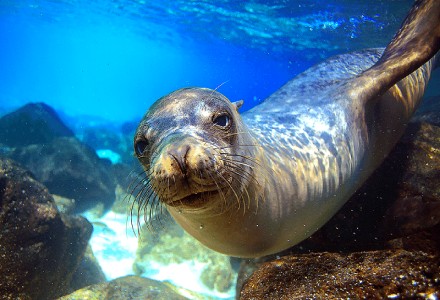
Mediterranean Monk Seal Facts
- First of all, the status of the Mediterranean Monk Seal probably ranks as the most important fact about the species. That holds true because, according to marine biologists, fewer than 700 individuals of this ocean species remain alive today. As a result, it remains the rarest known type of seal.
- As should come as no surprise, the IUCN currently lists the wonderful animal as Endangered. This occurs due to its scant numbers and extremely limited distribution. That actually represents a small improvement in the status, since the previous listing as Critically Endangered.
- This status change reflects a recent increase in its numbers. However, that increase represented only a minimal improvement in numbers. The action also remains in keeping with the speed-of-decline criteria employed by the IUCN. However, the organization also intends to reassess its status in 2020.
- Quite fortunately, preservation efforts have been instituted by the various governments in whose waters it makes its home. But, most unfortunately, these efforts continue to be hampered by various factors. These multiple factors include such things as high infant mortality rates and being caught in fishing nets.
Related Articles
Leopard Seal Steller Sea Lion Ringed Seal
Mediterranean Monk Seal Physical Description
The beautiful Mediterranean Monk Seal ranks as rather average for a pinniped, in terms of sheer size. Sexual dimorphism does exist in the species, but only to a very small degree. Males attain an average weight of about 710 lb (320 kg). Meanwhile, the smaller females average roughly 660 lb (300 kg).
But, the genders remain roughly equal in terms of length, however. Adults of both sexes reach an average length of 7.9 ft (2.4 m). These also display a gender-based difference in regards to coloring. Males typically display a primarily black color. Females, however, usually remain dark gray or brown.
In addition, both genders of the species display a pale underside. Yet, this typically presents as gray for females and white for males. Also, the fur of the creature ranks as the shortest of any known pinniped, regardless of gender. The snout grows broad and flat, while the flippers grow relatively short.
- Kingdom: Animalia
- Phylum: Chordata
- Class: Mammalia
- Order: Carnivora
- Suborder: Pinnipedia
- Family: Phocidae
- Genus: Monachus
- Species: M. monachus
Public Domain Image
Mediterranean Monk Seal Distribution, Habitat, and Ecology
Perhaps most notably of all, the lovable Mediterranean Monk Seal has an extremely limited and fragmented distribution. That holds true due to the fact that its only confirmed populations consist of three small colonies. Scientists currently suspect a fourth to exist, but it has not been confirmed.
The known populations exist in the Aegean Sea, near Greece, one near Turkey, and one near Cabo Blanco, close to Africa. The population near Greece, which also ranks as the largest, now calls the Alonissos Marine Park home. This provides at least part of the species with more protection.
This diurnal species also appears to feed primarily on a variety of fish and mollusks. This primarily includes squid and octopuses. It generally feeds near the surface but has been seen as deep as 500 ft (152.4 m). For the moment, marine biologists know very little about its reproductive practices.
Furthermore, there appears to be no set breeding season for this fascinating mammal. Bu, the majority of recorded births occur in the months of October and November. Finally, when not in the water, individual specimens prefer to inhabit sea caves, and occasionally appear on local beaches.
Species Sharing Its Region
Bearded Fireworm Blue Shark Hagfish
Check out our other articles on Dusky Dolphin, Araguaian River Dolphin, Hourglass Dolphin, Risso’s Dolphin, White Beaked Dolphin, False Killer Whale, Achrioptera manga

